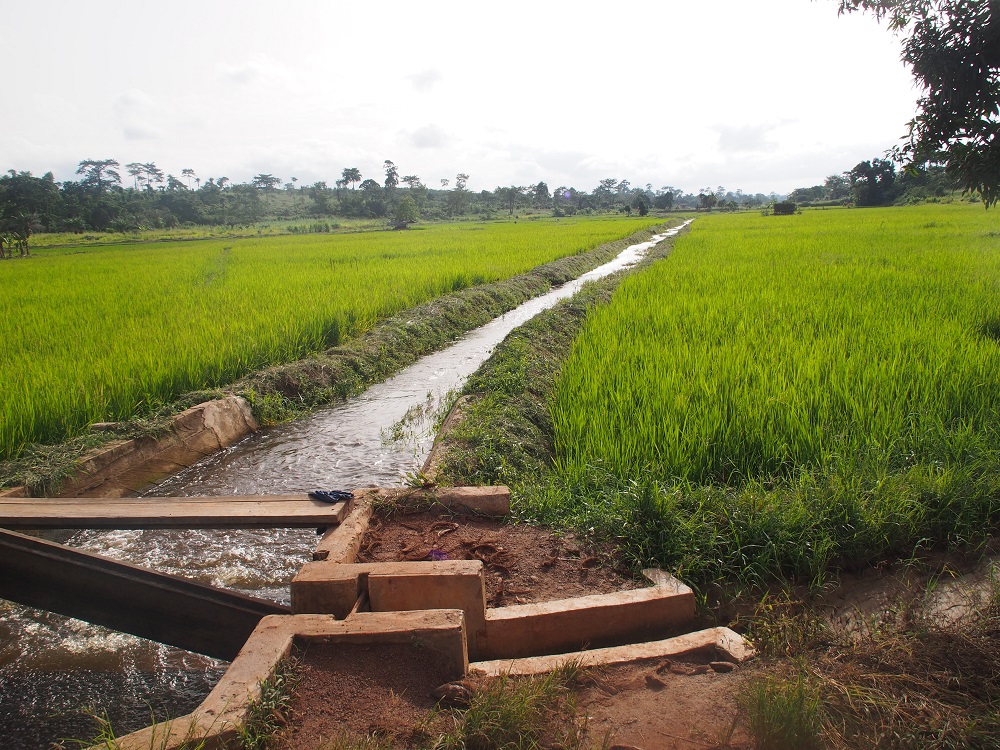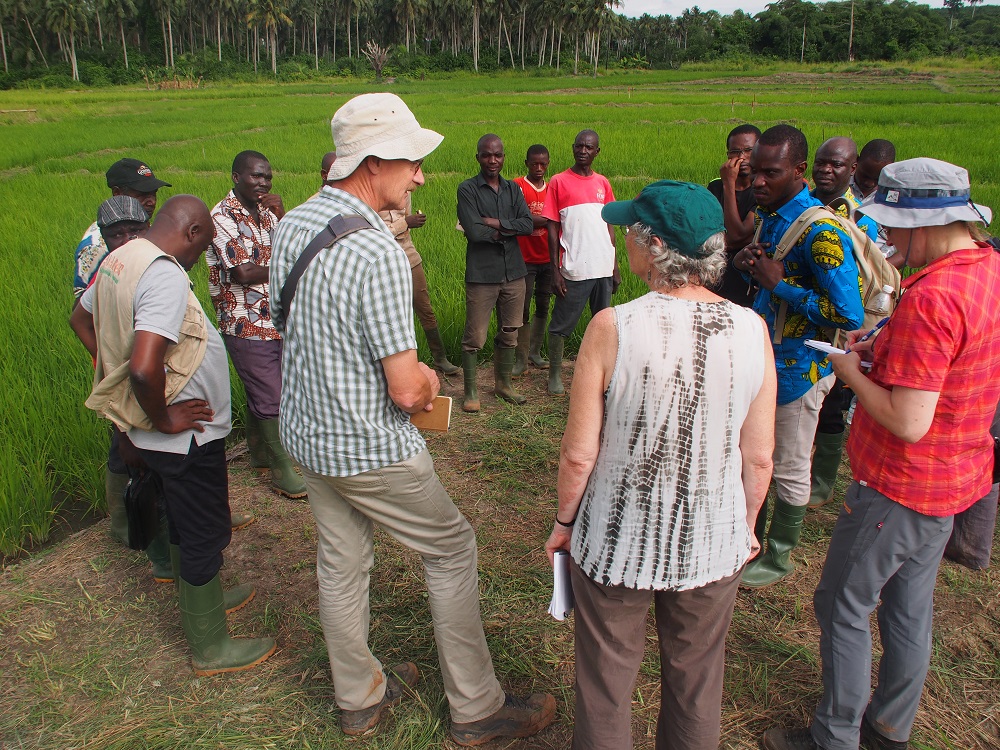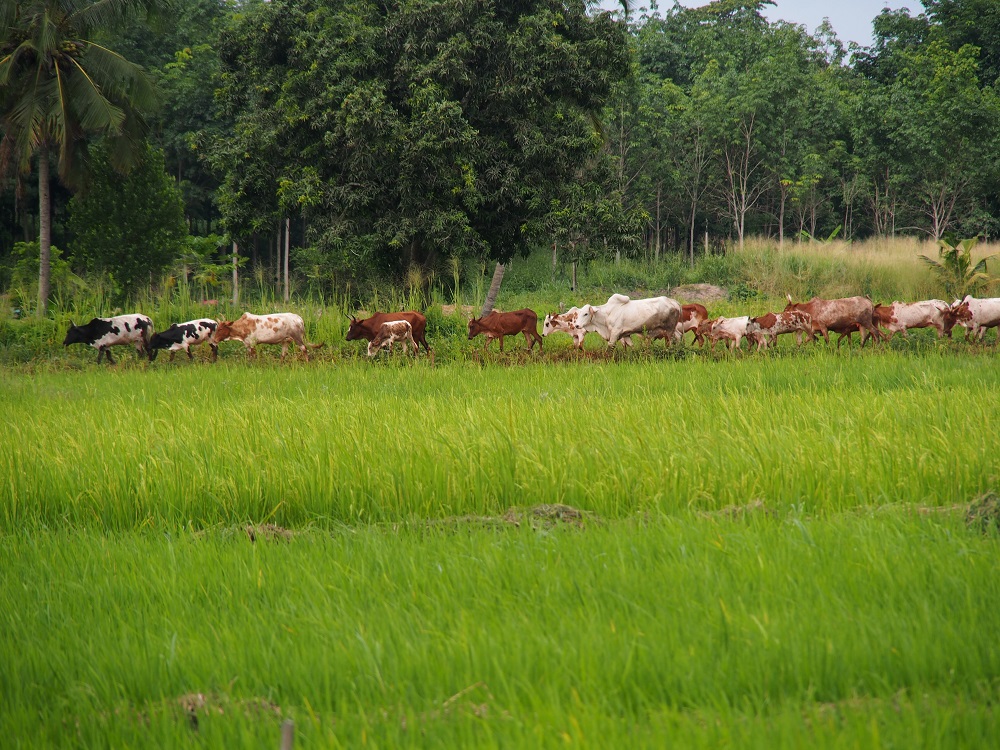Inland valleys are increasingly being considered as Africa’s future food baskets and unlocking their vast potential through ecological management could make the continent self-sufficient in rice.

Rice is the only major crop that can be grown under the temporary flooded conditions in inland valleys. (Photo by R Raman, AfricaRice)
Under normal circumstances, balancing and walking on rice bunds are not too difficult even for city dwellers. But, during the rainy season, this requires some acrobatic skills. This was the experience of a project team that recently toured selected inland valleys (a type of seasonally flooded wetland) in Gagnoa, Côte d’Ivoire, to interact with farmers and understand their concerns. The visit underlined the value of maintaining balance in the inland valleys in more ways than one. Inland valleys provide many crucial services to rural communities.
“It is essential to balance various competing uses in these lands, and improve agricultural production while preserving biodiversity and ecosystem services, which are important to people’s livelihoods and well-being,” said Josey Kamanda, a social scientist at Africa Rice Center (AfricaRice).
With an estimated area of 190 million hectares (ha), Africa’s inland valleys have a high potential for agriculture as these are blessed with fertile soils and a relatively abundant water supply. Although rice is often the main crop, inland valleys and their fringes are also used for growing other crops and grazing cattle, especially during the dry season.
The inland valley ecosystems provide several additional benefits to local communities such as hunting, fishing, and forest and forage resources as well as serve as biodiversity and wildlife sanctuaries. These are also important for local flood and erosion control, water storage, nutrient retention, and stabilization of the microclimate, among others.
Africa’s future food baskets
Because of rapid population growth and climate change, inland valleys are increasingly being considered as Africa’s future food baskets. Yet, their potential has hardly been tapped for agriculture. Only about 2% of the inland valleys are being used for rice production. AfricaRice believes that unlocking the vast potential of the inland valleys through ecological management could make the continent self-sufficient in rice.
Based on nearly three decades of research experience relating to inland valleys, AfricaRice and its partners have produced a range of methodologies and tools to characterize inland valleys and optimize their resource use such as “Smart-valleys” technology. An integrated water, soil fertility, and weed management approach has been developed that could raise average rice productivity by at least 1 ton/ha.
AfricaRice estimates that, with such yield increases, only about 13% of the 190 million ha of inland valley area would be enough for producing rice to fulfill the projected rice demand of 30 million tons of milled rice by 2035, assuming that irrigated and rainfed rice production remains constant. The remaining inland valley area could thus be safeguarded for other ecosystem services.

National and international researchers discussing with inland valley rice farmers about their priorities and constraints. (Photo by R Raman, AfricaRice)
Capitalizing the inland valley potential
Building on this experience, the 4-year project Capitalizing the inland valley potential for food and nutrition security for smallholder farmers in West Africa (CIPA) was launched in June 2018 with support from the International Fund for Agricultural Development (IFAD).
Focusing on Côte d’Ivoire and Ghana, CIPA is led by AfricaRice in partnership with Wageningen University and Research (WUR), the National Agricultural Research Center of Côte d’Ivoire (CNRA), the Council for Scientific and Industrial Research-Soil Research Institute of Ghana (CSIR-SRI), and MDF West Africa.
“CIPA will use a multi-stakeholder innovation platform approach to promote collective decision-making to reach consensus on the selection of inland valleys, optimization of land-use plans, and development of locally adaptable solutions,” explained Dr. Kamanda, who is the overall coordinator of the project. MDF West Africa is providing technical assistance and capacity building in the setting up of robust innovation platforms in the target countries.
The project seeks to enhance the productivity and competitiveness of inland valleys for rice-based systems through sustainable intensification and diversification and value chain development while conserving land and water resources and improving the resilience of local communities to the impacts of climate change.
About 2,000 rural households or around 10,000 people (of which at least 40% are women and 25% are youth) are expected to benefit directly from CIPA. They comprise farmers and other users of inland valley resources as well as traders, processors, and rural entrepreneurs. At least 20,000 more beneficiaries in each project country will indirectly benefit through the training and information products generated by the project.
Systematic approaches and methodologies
CIPA uses systematic approaches and methodologies for selecting the “best-bet” inland valleys (those most suitable for rice-based production with good marketing potential and low environmental and social risks), designing and implementing “best-fit” land- and water-use technologies within the inland valleys, and optimizing crop management practices for increased crop productivity.
“My study will contribute to the development of an optimal land-use scenario for inland valleys in Côte d’Ivoire and Ghana to ensure sustainable management of inland valley resources in the long term,” said Belew Tesfahun Alemayehu, a WUR/AfricaRice PhD student whose research on the effects of land-use planning on natural capital and economic and social well-being of inland valley stakeholders is supported by CIPA.
The project outputs will include, among others, a comprehensive inland valley development support tool; a national inland valley atlas for each project country; technological and organizational innovations to increase the productivity, sustainability, and climate resilience of inland valley agricultural production; policy briefs; and stakeholder-learning videos that will be actively promoted. A geospatial database with socioeconomic and biophysical characteristics of the inland valleys at the selected project sites is being developed.
“This will help us identify high-potential inland valleys for technology targeting of resource management and agronomic outcomes from the experimental sites,” said Confidence Duku, a postdoctoral fellow at WUR/AfricaRice working on CIPA.

In addition to rice, inland valleys and their fringes are used for growing a variety of crops and for cattle grazing. (Photo by R Raman, AfricaRice)
Development with conservation
Welcoming the CIPA project team to her rice field, Ossoue N’Guessan, chairperson of a rice farmers’ cooperative in Gagnoa, Côte d’Ivoire, said, “Thanks to my rice farm, I was able to send all my eight children to school. There is money in rice if we use good farming practices in the inland valleys and have access to appropriate machinery.”
“It is clear that rice is a very valuable crop for inland valley farmers like Mrs. N’Guessan,” said Guy Marius Assogba, PhD student from WUR/AfricaRice. “But it is not the only crop that they are growing. We also need to find out what kind of nonagricultural benefits they are getting from inland valleys.”
Mr.Assogba’s research on making the most of the potential of inland valleys to deliver both food and ecosystem services for local communities is supported by CIPA.
The project will link up with IFAD investment programs in the two project countries and will also connect with local and regional policymakers through the national programs CNRA in Côte d’Ivoire and CSIR-SRI in Ghana.
CIPA is a promising and innovative project, as it has the potential “to demonstrate that development can go hand in hand with natural resource conservation” according to IFAD.
________________
Ms. Mohapatra is the head of Marketing & Communications at AfricaRice.







